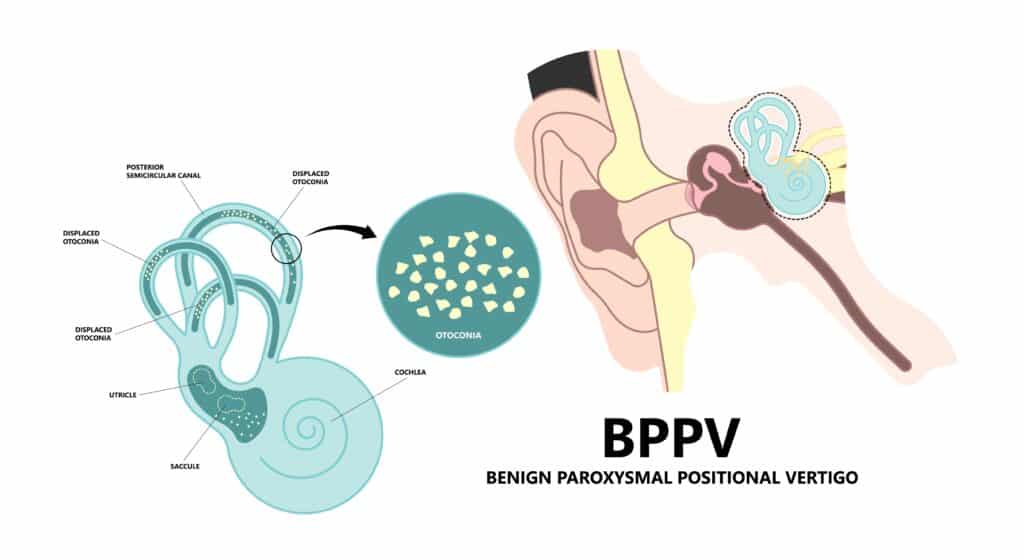Do you ever feel like the room is spinning even when you’re not moving? Does the spinning sensation last several seconds or even minutes?
If you answered yes, you might have vertigo.
Vertigo symptoms can cause problems ranging from having trouble getting out of bed or lying down, walking around your house, or even simply turning your head. Thankfully, there is a natural treatment for vertigo.
Specific home treatment exercises for vertigo can decrease or eliminate your symptoms to help you regain balance and stop vertigo attacks from becoming a chronic problem.

Causes of Vertigo
Vertigo is caused when there is a mismatch between what your brain tells your body, and your sense of balance becomes altered even if you aren’t moving, causing feelings of dizziness.
Vertigo most commonly affects people over age 65. It is also more likely to occur in women than men, though anyone can experience vertigo. As we age, we are more likely to develop vertigo due to natural aging.
Dizziness can happen if you take multiple medications, have low blood pressure, or have a sudden drop in blood pressure. It can also result from head or neck injuries.
Both dizziness and vertigo can affect your daily life. When you are dizzy, you might feel lightheaded or faint. With vertigo, you feel like you or your surroundings are spinning.
Both conditions can cause instability and a loss of balance. If symptoms are more severe, you might experience headaches, migraines, hearing loss, motion sickness, ear ringing (tinnitus), nausea, vomiting, or blurry/double vision.
Vertigo attacks can last as little as a few seconds or minutes. With severe vertigo, these episodes can occur for days or even months. The intensity and duration of attacks depend on the cause.
There are two different forms of vertigo:
Peripheral vertigo is a problem with the inner ear, such as inflammation of the vestibular nerve, BPPV, trauma, or Meniere’s disease.
Central vertigo is related to a problem with the brain due to an injury, stroke, tumor, or viral infection.
Peripheral vertigo symptoms are the most common reason for dizziness or a spinning sensation. Fortunately, it is possible to treat common peripheral vertigo at home.
What is Benign Paroxysmal Positional Vertigo (BPPV)?
BPPV is the most common type of (peripheral) vertigo. It usually occurs for seconds or minutes after changing the position of your body or head. This is why you might experience a spinning sensation when you turn your head, look up, turn onto your side, or lie in bed.
BPPV stands for Benign Paroxysmal Positional Vertigo:
Benign: the cause of dizziness is not a threat to your health.
Paroxysmal: the dizziness comes in short bursts.
Positional: the dizziness occurs from particular body or head positions.
Vertigo: the medical term for the spinning sensation

BPPV involves a problem with the inner ear. Inside your ear, tiny calcium carbonate crystals sit in your ear canals (called semi-circular canals). When these crystals loosen from where they should be, they start floating around or attaching to other canal parts.
When these crystals dislodge, moving your head a certain way causes the crystals to move too. This tricks your brain into thinking you’re moving when you’re not. If you stay in the position that gave you the brief spinning sensation, the crystals will settle in their new place.
Crystals can dislodge for many reasons, including dehydration, rapid changes in elevation, bumping your head, or falling. It also can happen as you age, sometimes for no identifiable cause.
The dizziness will eventually wear off, but symptoms may return when you move your body or head again.
Some of these provoking movements include:
Getting in or out of bed quickly
Turning onto your side in bed or on the couch
Looking up to reach for something on a high shelf
Performing daily or job-related activities that require you to tilt your head back
If you suspect you have BPPV, it’s best to consult your doctor so they can perform a thorough exam. They’ll ensure your dizziness isn’t caused by a stroke, medication side effect, or low blood pressure. Your doctor might have you perform specific hearing or balance tests to diagnose appropriately.
Sometimes vertigo will resolve itself spontaneously within a few weeks or months. If left untreated, vertigo remains in about 30% of patients.
Once you have been diagnosed with BPPV, there are many positioning maneuvers you can do yourself to resolve your vertigo. With some basic training, you can return to doing what you love without fear.

Home Treatment
Suppose you’re experiencing that spinning sensation or have been diagnosed with BPPV. You can relieve your symptoms at home by performing natural, research-supported, safe, and free vertigo exercises.
These are known as repositioning maneuvers, as they reposition loose crystals in your inner ear to where they belong. This will stop the spinning sensation.
Initially, these maneuvers are typically performed in a clinic. Your physical therapists can assist you with each maneuver to ensure proper head position and wait time between each step.
Other treatments for vertigo include medication, neurologic physical therapy, and, rarely, surgery.
Be sure to consult with your doctor before trying any at-home treatment plan or exercise program.
Home Epley Maneuver
The home Epley maneuver is highly effective as a home treatment. It involves turning your head and body in certain positions based on the side on which your symptoms occur.
It’s important to note the position of your head when your vertigo episodes occur.
For example, suppose you experience vertigo when turning your head to the left. In that case, you will perform these movements starting with your head turned to the left. You would follow a different, reversed pattern on the right.
How to perform the Home Epley Maneuver:
Sit upright on your bed or on a flat surface with your legs in front of you. You can place a pillow behind you beforehand for when you lie down.
Turn your head 45 degrees to the left.
With your head still turned to the left, quickly lie down on your back. Your head should either be hanging off the edge of the bed or slightly off the edge of the pillow. Keep your head in this position for 30-60 seconds or until your feeling of dizziness stops.
Turn your head to 45 degrees to the right, keeping your head hanging over the edge of your bed or pillow. Wait another 30-60 seconds or until your symptoms stop.
Turn to lie on your right side, keeping your head turned to the right. Wait for 30-60 seconds.
Slowly sit up to your starting position, sitting upright and facing your head forward.
Stay there for 15 minutes and repeat these steps again.
If your doctor or physical therapist performs the Epley maneuver, you may still need to complete it again when you get home. You can repeat these exercises if your symptoms persist or if an episode of dizziness arises again.
Semont Maneuver
The Semont maneuver is another easy and natural treatment for vertigo. This maneuver is less well-known than the Epley maneuver, but research has shown it is just as effective.
How to perform the Semont maneuver:
Sit upright on your bed or a flat surface with your legs hanging off the edge.
Turn your head 45 degrees to the right if your left ear is affected.
With your head still turned to the right, quickly lie down on your left side so that you’re looking up. You can swing your legs up onto the bed simultaneously for comfort if you’d like. Stay in this position for 30-60 seconds or until your feeling of dizziness stops.
Keeping your head turned to the right, quickly sit up and lie on your right side so that you’re now looking down at the bed. Again, you can swing your legs up onto the bed at the same time. Wait another 30-60 seconds or until your symptoms stop.
Slowly sit up to your starting position, sitting upright and facing your head forward.
Repeat these steps three more times and perform this sequence three times a day.
Half-Somersault or Foster Maneuver
You can perform the Half-Somersault/Foster Maneuver based on your comfort level by kneeling on a cushioned floor or a soft mat table.
How to perform the Half-Somersault or Foster Maneuver:
Kneel down and tilt your head back to look up at the ceiling.
Bend your body forward, so your hands brace the ground before you and your head touches the floor. Make sure you tuck your chin closer to your knees. Stay in this position for 30 seconds or until your dizziness stops.
Turn your head 45 degrees to the side on which you usually get vertigo (Turn your head to the left if turning to the left usually brings on your symptoms). Wait another 30 seconds.
With your head still turned to the right, quickly lift your head to align with your back. You will now be on your hands and knees. Wait 30 seconds.
With your head still to the right, quickly straighten your torso to kneel upright.
Wait 15 minutes in the kneeling position, or slowly stand up while you wait.
Repeat this sequence 2-3 more times as needed.
Brandt-Daroff Exercise
The last natural treatment for peripheral vertigo we’ll discuss is the Brandt-Daroff exercise. This is most commonly recommended as a home treatment because it’s easy to perform on your own.
How to perform the Brandt-Daroff Exercise:
Sit upright on your bed or a flat surface with your legs hanging off the edge.
Turn your head to the left side as far as possible, then lay your head and torso down on your right. Your legs should not move. Stay here for at least 30 seconds.
Sit up and turn your head back to the center position.
Repeat the exercise on the opposite side by turning your head as far as possible to the right, then lying down on your left side.
Repeat this sequence 5 times. Do this 3 times a day, twice a week.
Safety Considerations
Overall, all of these treatments for peripheral vertigo are safe for you to perform at home. Still, there are some safety considerations and side effects to keep in mind:
For some people, vertigo can worsen after the Epley maneuver, including nausea or vomiting. If your vertigo worsens after the Epley maneuver, try to perform this treatment when someone else is with you.
Practice caution after completing these maneuvers, as your dizziness or vertigo may suddenly return. Please wait until you feel steady before moving, and it’s best to avoid driving until you feel confident that you’re feeling better.
These methods are effective over time, and it’s common to continue experiencing vertigo that diminishes over time. Continue to use these methods until your vertigo begins to dissipate.
Some positions may require more than your back and neck can handle. If you encounter pain, ask your doctor or physical therapist if any of these home treatments for vertigo are safe for you.
After these sessions, try not to tilt your head too far up or down for the rest of the day. It helps to sleep with an extra pillow to keep your neck straight at night.
Once your dizzy spells go away, you can stop performing the exercises. However, if they return weeks or years from now as BPPV often does, do the home Epley maneuver again to relieve your symptoms of vertigo.
If you still don’t find relief, consult your doctor to review the series of movements and receive a thorough exam to assess any changes or to explore other options.
Getting Further Help
Talk to your doctor or physical therapist if you find the Epley maneuver and other exercises ineffective. You should ensure that you are performing them correctly. If you are doing them correctly but are still experiencing vertigo attacks, there might be something else that is causing your vertigo.
There are many other treatment options you can discuss with your doctor. These include:
Medications that relieve migraines, dizziness, or nausea
Drugs or counseling to treat dizziness caused by anxiety or stress, or stress management techniques.
Vertigo-specific physical therapy (often called vestibular rehabilitation therapy
Dietary counseling for a low-sodium diet or to identify trigger foods
Inner ear injections or other treatments for inner ear infections
Internal ear surgery (in rare cases)
Summary
The Epley maneuver, Semont maneuver, Half-Somersault maneuver, and Brandt-Daroff exercise are all common and highly effective physical therapy-based treatments for vertigo symptoms. They are reliably effective for treating your BPPV.
BPPV symptoms are complex, but these basic maneuvers quickly resolve vertigo, dizziness, and balance issues. Finally, your central nervous system will sense the information equally from both ears giving you the stability you have been looking for so you can move confidently to improve your quality of life.
References:
Home Epley maneuver. Home Epley Maneuver | Johns Hopkins Medicine. (2021, December 13). Available from https://www.hopkinsmedicine.org/health/treatment-tests-and-therapies/home-epley-maneuver
Home Epley maneuver to treat BPPV (right ear) – patient information – UHS. Patient Information Leaflets. (n.d.). Available from https://www.uhs.nhs.uk/Media/UHS-website-2019/Patientinformation/Audiology/Home-Epley-manoeuvre-to-treat-BPPV-right-ear-2783-PIL.pdf
Department of Health & Human Services. (2003, January 23). Dizziness and vertigo. Better Health Channel. Available from https://www.betterhealth.vic.gov.au/health/conditionsandtreatments/dizziness-and-vertigo
Strupp, M., & Brandt, T. (2008). Diagnosis and treatment of vertigo and dizziness. Dtsch Arztebl Int., 105(10), 173–180. https://www.ncbi.nlm.nih.gov/pmc/articles/PMC2696792/
InformedHealth.org. Cologne, Germany: Institute for Quality and Efficiency in Health Care (IQWiG); 2006-. Benign paroxysmal positional vertigo: What can you do if you have BPPV? [Updated 2020 Apr 9]. Available from: https://www.ncbi.nlm.nih.gov/books/NBK556950/
U.S. National Library of Medicine. (n.d.). Dizziness | vertigo. MedlinePlus. Available from https://medlineplus.gov/dizzinessandvertigo.html







